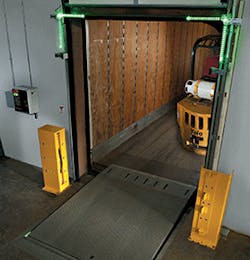Safety doesn’t happen by accident—especially in material handling operations that carry high elements of risk. Two of the most important ingredients in delivering a safe work environment are using the right equipment for the task and maintaining the equipment to minimize potential failures.
Trailer separation accidents, forklift and pedestrian collisions, and other mishaps at the loading dock can lead to injuries, product and facility damage, lawsuits and a bad reputation.
Take these staggering numbers from OSHA into account:
• Forklift-related fatalities occur every three days.
• There are 94,750 reported cases of non-fatal forklift accidents per year.
• An estimated $135 million in direct costs are related to these accidents, and indirect costs are likely five times that amount
While the exact cause of these accidents is specific to each case, there’s no doubt that the likelihood of them occurring increases when improper or faulty equipment is used. Even the most well-trained forklift operator is prone to injury if a leveler or vehicle restraint fails during loading or unloading.
Advancements in loading dock technology and the proliferation of planned maintenance programs are reducing risks for material handling facilities and—more importantly—workers.
Design Safety In with the Right Equipment
With heavy equipment moving continually both inside and out, loading docks are among the most dangerous places in any industrial operation. Finding the right equipment to keep workers and product safe is a good starting point.
During trailer loading and unloading, the two most importance pieces of equipment in ensuring a safe and efficient operation are the vehicle restraint and the dock leveler. Whether it’s a 53-foot over-the-road trailer, a refrigerated trailer on back hauls or an intermodal cargo container on a chassis with an obstructed RIG, the restraint must effectively secure the load to the dock. What once was done with a rotating-hook trailer restraint must now be handled with various set-ups, including “shadow hook” restraints, specialized stabilized trailer restraints, and even wheel-based restraints for lift-gate trailers and tankers.
Another injury risk for loading dock workers is the bridge from the facility to the trailer—the leveler. With forklift tires often made from solid rubber and lacking a suspension system of any kind, every little bump along the way delivers a shot up an operator’s spine and into the shoulders and neck. Levelers, while functionally necessary, often supply the biggest jolts a forklift operator experiences and is commonly referred to as “dock shock.”
Because of the way levelers are engineered, there are usually two main vibration points—where the dock plate meets the warehouse floor and the raised crown of the front lip hinge of the leveler. More ergonomically-friendly levelers have been designed in recent years that use smoother transitions at these two vibration points, which can reduce dock shock by 50%.
Minimizing dock shock not only enhances employee well-being, it also reduces damage to dock equipment, forklifts and the products those forklifts carry.
Whether it’s preventing trailer separation accidents with advanced vehicle restraints or minimizing the effects of dock shock with smooth-transition hydraulic levelers, the proper equipment can instantly enhance safety at any material handling facility.
Upgradeable Loading Dock Equipment
While some of the basic equipment is a good start, facility managers should look beyond these basic elements. As new technologies emerge for loading docks (especially multi-sensory hazard recognition systems), facility managers should look for safety systems that offer equipment that can be easily upgraded.
For example, the red light/green light visual communication system has gained considerable favor in the last few decades. However, these types of light communication devices are being overhauled to further improve safety for workers and protect products and equipment from damage. More advanced multisensory safety technology is becoming available and easier to implement.
Inside the loading dock, LED lights in the corners of dock openings provide status-at-a-glance communication for forklift operators before entering a trailer, while LED lights located near the leveler provide visual cues when inside the trailer. These LED light systems can be added to virtually any existing dock set-up. Another system uses motion-sensors to detect activity inside a trailer. When it does, it projects a blue light (similar to forklift safety lights) to alert workers that a forklift could back out at any moment, while simultaneously locking the vehicle restraint so a trailer cannot pull away.
Similarly, motion-sensors are being incorporated outside of the loading dock to detect when a trailer is backing into position. An audible alarm sounds and a strobe light starts when motion is detected in the drive approach. Considering a majority of the 60 loading dock-related deaths reported in the previous three years are the result of a worker being crushed by a backing trailer, this technology can help save lives.
These important upgrades will help keep loading dock areas safe into the future. However, they won’t be able to do it well unless they’re maintained properly.
Reactive Maintenance is Asking for Trouble
Even the best loading dock equipment won’t last forever. The average leveler will experience nearly 100,000 crossings by a 9,000-pound (or heavier) forklift during a single year. Vehicle restraints will take punishment from trailers bouncing up and down during loading/unloading, not to mention any unintentional early trailer departures.
It’s this kind of abuse that happens every day at the loading dock that makes it necessary to provide routine maintenance on equipment. While it’s easy to delay equipment checks for months or years, especially if the equipment is new, ignoring regular maintenance can lead to a disastrous breakdown.
More than half of facilities across the U.S. take a reactive approach to maintenance. In fact, a whopping 55% of companies use the wait-and-see method. That same study recommended reactive maintenance should be used only 20% of the time.
On one hand, these organizations don’t have to employ another worker (or more) to provide regular maintenance and daily operations aren’t negatively affected. However, when equipment does inevitably fail, the breakdowns can have significant cost implications and the equipment might need to be completely replaced. The costs associated with an initial diagnosis and then full replacement can be shocking. Due to the imminent need of fixing unplanned down equipment, work may need to be scheduled as emergency service or billed at overtime rates as labor and spare parts may not be available when something goes down unexpectedly.
Adding insult to injury, equipment breakdowns can lead to hours or even days of unproductive downtime. This translates into a reduced throughput that doesn’t only hurt the bottom line; it can damage reputations.
Planned Maintenance Adds Safety and Efficiency
The key is to identify wear and tear on equipment before it suffers a serious breakdown. In worst-case scenarios, breakdowns can lead to severe injuries for workers. While inspections and routine maintenance will temporarily limit use of a dock, it’s always better to know when docks are going to be down instead of suffering unplanned equipment failures with indefinite downtime.
Internal facility workers who are able to provide equipment inspections can fill this role in some instances. An even better option is to find certified professionals who diagnose and repair dock equipment every day as part of a planned maintenance program (PMP). These professionals can provide services that internal maintenance workers just don’t have the expertise for. If equipment isn’t working properly, certified PMP technicians will not only be able to fix the problem, they’ll be able to get to the root cause and offer solutions to prevent a similar failure in the future.
If an emergency does take place, a certified technician can tend to the situation quickly and more affordably than a technician who is seeing the facility for the first time.
Planned maintenance programs generally start with a free facility survey. The survey acts as a starting point for the PMP provider and the facility manager to determine the state of the facility and what type of program is needed. Depending on the needs of your facility, PMP inspections can be scheduled monthly, quarterly, semi-annually, or yearly.
In addition to providing maintenance, technicians can red flag equipment that has been compromised. Their advanced training allows them to identify and diagnose equipment problems that might not demonstrate any immediate symptoms. The ability to spot small problems early on can allow for different methods to be used to potentially extend the life of the piece of equipment. It also allows facility managers to begin budgeting for eventual equipment replacement.
Combine the Right Equipment with Regular Maintenance
There’s not a single solution that will make a loading dock or facility completely safe. It takes a series of measures to reduce as much risk as possible to create the safest working conditions possible.
The first step in creating this environment is to make sure the right equipment is being used. While specifying the most advanced model available is ideal, it’s even more important to find the equipment that best suits daily operations. When possible, look for equipment that can be augmented with additional safety features in the future, like multisensory hazard recognition systems.
Maintaining material handling equipment is the second step in producing the safest environment possible. Because equipment can take a beating during normal loading dock operations, make sure to have a planned maintenance program to keep it all in proper working order. Facilities that do are helping ensure the safety of their employees and products.
Walt Swietlik is director of customer relations and sales support for Rite-Hite, a manufacturer of loading dock equipment.




